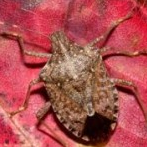 Illinois residents need to take steps to prepare for the invasion of Halyomorpha halys, better known as the brown marmorated stink bug (BMSB), warns University of Illinois horticulture educator Kelly Allsup.
Illinois residents need to take steps to prepare for the invasion of Halyomorpha halys, better known as the brown marmorated stink bug (BMSB), warns University of Illinois horticulture educator Kelly Allsup.
The BMSB is on the 2012 Most “Unwanted” Invasive Pests list created by the Illinois Cooperative Agriculture Pest Survey Program. With their piercing mouthparts, these insects are capable of damaging a multitude of crops, such as apples, pears, soybeans, and landscape ornamentals. “BMSB are capable of causing economic losses to soybean and corn producers,” said U of I Extension entomologist Mike Gray.
According to Kelly Estes, state survey coordinator of the Illinois Cooperative Agricultural Pest Survey, the combination of low populations of BMSB and highly managed crop systems in Illinois have kept economic injury levels low up to now. However, recent tracking by the USDA indicates that BMSB spread substantially during this last growing season.
The drought may have reduced the impact of fungal disease on the insects, with the warm weather causing them to develop faster. The warm fall has allowed two generations to be produced during one growing season, resulting in a greater number of overwintering insects.
As well as damaging crops, these invasive pests seek shelter in homes during the winter. They enter via cracks and crevices to overwinter.
“Most reports have come from urban areas in early spring and fall, generally from homeowners and master gardeners,” said Estes. To control BMSB in the home, use a vacuum to suck up adults or caulk the house in early winter. Using sprays indoors is not recommended because insecticide residues do not provide effective control.
Stink bugs are capable of aggregating in man-made structures, and recent USDA studies show they prefer large dead trees that are still standing in the forest, such as oak or hickory on the East Coast. In April after overwintering, the adult lays 20 to 30 eggs. Nymphs emerge shortly after. There can be multiple generations per year, depending on temperatures.
BMSB has been identified in 38 states. Although Illinois is currently classified by the USDA as being at low risk for the pest, and large numbers have not been recorded, Allsup encourages homeowners and gardeners to be on the lookout for this invasive pest.
BMSB has the characteristic stink bug shield shape and is as wide as it is long. It has distinctive black and white banding on the antennae and alternating dark/light banding on the edge of the wings.
If you suspect you have BMSB, place the specimen in a plastic bag or jar and bring it to the local Extension office.






Post a comment
Report Abusive Comment